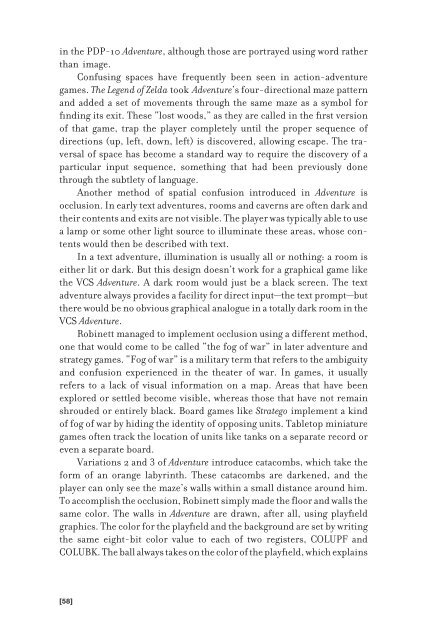Racing the Beam : the Atari Video Computer System - Index of
Racing the Beam : the Atari Video Computer System - Index of
Racing the Beam : the Atari Video Computer System - Index of
Create successful ePaper yourself
Turn your PDF publications into a flip-book with our unique Google optimized e-Paper software.
in <strong>the</strong> PDP-10 Adventure, although those are portrayed using word ra<strong>the</strong>r<br />
than image.<br />
Confusing spaces have frequently been seen in action-adventure<br />
games. The Legend <strong>of</strong> Zelda took Adventure’s four-directional maze pattern<br />
and added a set <strong>of</strong> movements through <strong>the</strong> same maze as a symbol for<br />
fi nding its exit. These “lost woods,” as <strong>the</strong>y are called in <strong>the</strong> fi rst version<br />
<strong>of</strong> that game, trap <strong>the</strong> player completely until <strong>the</strong> proper sequence <strong>of</strong><br />
directions (up, left, down, left) is discovered, allowing escape. The traversal<br />
<strong>of</strong> space has become a standard way to require <strong>the</strong> discovery <strong>of</strong> a<br />
particular input sequence, something that had been previously done<br />
through <strong>the</strong> subtlety <strong>of</strong> language.<br />
Ano<strong>the</strong>r method <strong>of</strong> spatial confusion introduced in Adventure is<br />
occlusion. In early text adventures, rooms and caverns are <strong>of</strong>ten dark and<br />
<strong>the</strong>ir contents and exits are not visible. The player was typically able to use<br />
a lamp or some o<strong>the</strong>r light source to illuminate <strong>the</strong>se areas, whose contents<br />
would <strong>the</strong>n be described with text.<br />
In a text adventure, illumination is usually all or nothing: a room is<br />
ei<strong>the</strong>r lit or dark. But this design doesn’t work for a graphical game like<br />
<strong>the</strong> VCS Adventure. A dark room would just be a black screen. The text<br />
adventure always provides a facility for direct input—<strong>the</strong> text prompt—but<br />
<strong>the</strong>re would be no obvious graphical analogue in a totally dark room in <strong>the</strong><br />
VCS Adventure.<br />
Robinett managed to implement occlusion using a different method,<br />
one that would come to be called “<strong>the</strong> fog <strong>of</strong> war” in later adventure and<br />
strategy games. “Fog <strong>of</strong> war” is a military term that refers to <strong>the</strong> ambiguity<br />
and confusion experienced in <strong>the</strong> <strong>the</strong>ater <strong>of</strong> war. In games, it usually<br />
refers to a lack <strong>of</strong> visual information on a map. Areas that have been<br />
explored or settled become visible, whereas those that have not remain<br />
shrouded or entirely black. Board games like Stratego implement a kind<br />
<strong>of</strong> fog <strong>of</strong> war by hiding <strong>the</strong> identity <strong>of</strong> opposing units. Tabletop miniature<br />
games <strong>of</strong>ten track <strong>the</strong> location <strong>of</strong> units like tanks on a separate record or<br />
even a separate board.<br />
Variations 2 and 3 <strong>of</strong> Adventure introduce catacombs, which take <strong>the</strong><br />
form <strong>of</strong> an orange labyrinth. These catacombs are darkened, and <strong>the</strong><br />
player can only see <strong>the</strong> maze’s walls within a small distance around him.<br />
To accomplish <strong>the</strong> occlusion, Robinett simply made <strong>the</strong> fl oor and walls <strong>the</strong><br />
same color. The walls in Adventure are drawn, after all, using playfi eld<br />
graphics. The color for <strong>the</strong> playfi eld and <strong>the</strong> background are set by writing<br />
<strong>the</strong> same eight-bit color value to each <strong>of</strong> two registers, COLUPF and<br />
COLUBK. The ball always takes on <strong>the</strong> color <strong>of</strong> <strong>the</strong> playfi eld, which explains<br />
[58]


